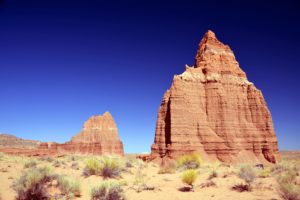
Photo Credit: Temple of the Sun and Moon, Cathedral Valley. Photo by Annette Lamb
Celebrating Our Heritage of Rocks and Collecting
Whether planning for gold in the Henry Mountains or hiking to Hickman Bridge, Wayne County has a history connected with the Earth. Carving stone tools, using a grindstone to make corn meal, and etching stories in stone are just a few examples of how rocks has been important to local people since prehistoric times.
When pioneers first settled in Rabbit Valley, mineral prospectors weren’t far behind. The Henry Mountains gold rush (1890s), the Faculty Butte coal mine (1900s), the Miner’s Mountain copper quest (1910s), and the uranium boom (1950s) are just a few examples of the many times when people sought riches in mining. From gold and copper to coal and uranium, there are currently over 70 active mines in the county. In Capitol Reef alone, there are over 62 historical mine sites with fifteen still in need of mitigation.
In the 1920s, Ephraim Pectol and Joe Hickman began promoting the area as Wayne Wonderland because of its colorful canyons, buttes, and monoliths. In 1937, Capitol Reef was designated a National Monument to protect the area’s geologic features. Finally, Capitol Reef National Park was established in 1971. Over a million visitors enjoy the beauty of the unique geology of the area each year.
“Doc” Inglesby of Fruita and Worthen Jackson of Fremont are just two of the many early, Wayne County rock collectors. Rock collecting is a hobby that’s often passed from one generation to the next. How well do you know the laws regarding collecting rocks? Keep in mind that you may not collect rocks or fossils of any kind from National Park land. Surface collection of rocks, agates, common invertebrate/plant fossils, and petrified wood is permitted in small quantities without a permit on both US Forest Service and Bureau of Land Management lands. Collecting arrowheads or other artifacts more than 50 years old is not permitted. A permit is required for collecting meteorites or vertebrate fossils on US Forest Service land. Most state-owned property requires a permit to collect rocks. Check with the land owner before collecting on private property. If you find a large fossil such as a dinosaur bone, report it to the Utah Geologic Survey.
Want to learn more? The Entrada Institute is partnering with USU Extension and 4-H to provide a free, community dinner on Wednesday April 25 at 6PM at the Wayne County Community Center in Bicknell. Everyone is invited. Bring your friends and family. The community night will include a free meal, historical perspectives on mining, a slide show, engaging activities, exhibits featuring rock collections, and a demonstration of rock carving. If you’re planning to join us, please call the USU Extension/4-H Office at 435-836-1312 or Annette Lamb at 435-425-3415 to let us know how many will be attending.
Do you make rock jewelry, collect rocks, pan for gold, or make rock arts and crafts products? Bring your favorites to the dinner for our exhibition. We’re also looking for people to demonstrate rock arts and crafts. In addition, we’re seeking historical photographs related to rocks and mining. Contact Project Director Annette Lamb at info@entradainstitute.org or call 435-425-3415 for more information. This project is made possible through a generous grant from the National Endowment for the Humanities and the Entrada Institute. LIKE us at facebook.com/sparkinghumanities. – Annette Lamb, The Entrada Institute
